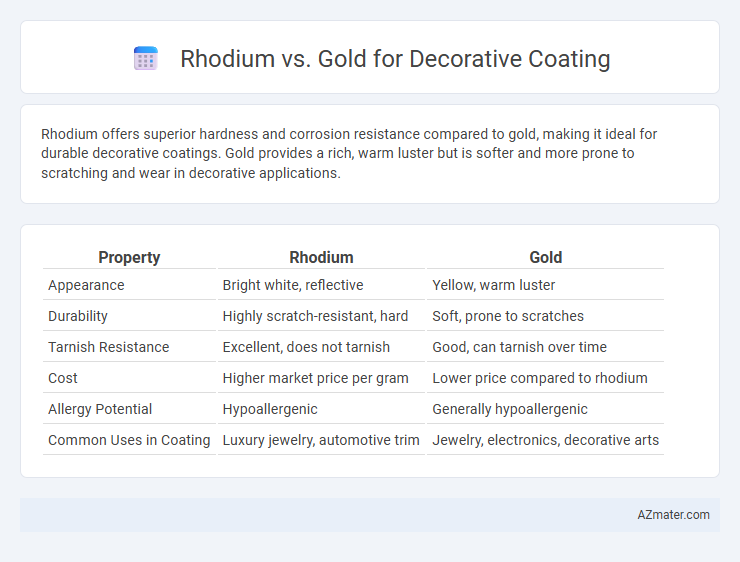Rhodium offers superior hardness and corrosion resistance compared to gold, making it ideal for durable decorative coatings. Gold provides a rich, warm luster but is softer and more prone to scratching and wear in decorative applications.
Table of Comparison
| Property | Rhodium | Gold |
|---|---|---|
| Appearance | Bright white, reflective | Yellow, warm luster |
| Durability | Highly scratch-resistant, hard | Soft, prone to scratches |
| Tarnish Resistance | Excellent, does not tarnish | Good, can tarnish over time |
| Cost | Higher market price per gram | Lower price compared to rhodium |
| Allergy Potential | Hypoallergenic | Generally hypoallergenic |
| Common Uses in Coating | Luxury jewelry, automotive trim | Jewelry, electronics, decorative arts |
Introduction to Rhodium and Gold in Decorative Coating
Rhodium and gold are both prized metals extensively used in decorative coating for jewelry and luxury items due to their unique aesthetic and protective properties. Rhodium, a rare platinum-group metal, offers a brilliant, reflective white finish with exceptional resistance to tarnish and scratches, making it ideal for enhancing the durability and shine of white gold and silver items. Gold, known for its rich yellow luster and corrosion-resistant qualities, provides luxurious warmth and timeless appeal, often alloyed in various purities to tailor color and hardness in decorative applications.
Key Properties of Rhodium and Gold
Rhodium offers exceptional hardness, corrosion resistance, and a high-reflective, bright white finish, making it ideal for decorative coating on jewelry and luxury items that require durability and scratch resistance. Gold provides excellent tarnish resistance, a warm yellow hue, and malleability, which allows for intricate designs but is softer and less resistant to wear compared to rhodium. Both metals enhance aesthetic appeal, with rhodium favored for protective topcoats and gold prized for its classic luster and value.
Aesthetic Appeal: Color and Finish Differences
Rhodium offers a bright white, highly reflective finish that enhances the brilliance of jewelry and accessories, providing a modern, sleek look compared to gold's warm yellow and rich, classic glow. Gold's various karats can range from rich yellow to rose or white hues, offering versatility in aesthetic appeal, whereas rhodium is typically used as a plating material to achieve a durable, tarnish-resistant surface. The distinct contrast in color and finish between rhodium's cool, mirror-like sheen and gold's varied warm tones makes each suited for different decorative coating preferences and style statements.
Durability and Wear Resistance Comparison
Rhodium offers superior durability and wear resistance compared to gold, making it a preferred choice for decorative coatings that require long-lasting protection against scratches and tarnish. Its hardness, typically around 6 on the Mohs scale, significantly exceeds gold's softer nature, which ranges from 2.5 to 3, ensuring rhodium plating maintains its bright, reflective finish for extended periods. While gold provides excellent corrosion resistance and aesthetic warmth, rhodium's robustness and ability to retain luster under heavy use make it ideal for jewelry, watches, and luxury accessories requiring enhanced surface resilience.
Tarnish and Corrosion Resistance
Rhodium offers superior tarnish and corrosion resistance compared to gold, making it a preferred choice for decorative coatings on jewelry and high-end watches. Its inert nature prevents oxidation and discoloration, ensuring a long-lasting, bright, reflective finish. Gold, while resistant to corrosion, is prone to tarnish over time when exposed to sulfur compounds, requiring more frequent maintenance.
Cost Analysis: Rhodium vs Gold
Rhodium plating costs significantly less than gold, with rhodium priced around $400 per ounce compared to gold's approximate $2,000 per ounce market value. The durability of rhodium, which resists tarnishing and scratches better than gold, reduces the need for frequent re-coating, lowering long-term maintenance expenses. When assessing decorative coatings, rhodium offers a more cost-effective solution without sacrificing aesthetic appeal, especially for pieces requiring a bright, reflective finish.
Application Methods in Decorative Coating
Rhodium and gold coatings are applied using distinct methods tailored to their unique properties for decorative purposes. Rhodium is typically deposited through electroplating, which provides a bright, reflective surface and excellent scratch resistance ideal for jewelry and watches. Gold decorative coatings often use both electroplating and physical vapor deposition (PVD), offering a range of finishes from traditional yellow gold to rose and white gold, enhancing durability and color consistency.
Common Uses in Jewelry and Accessories
Rhodium is widely used as a plating material for jewelry and accessories due to its brilliant white finish and superior resistance to tarnish, making it ideal for enhancing the appearance of white gold, silver, and platinum pieces. Gold, especially in its 14K and 18K forms, remains a popular choice for decorative coatings because of its natural luster, hypoallergenic properties, and ability to maintain color over time. Jewelry designs often feature rhodium plating to provide a reflective, durable surface, while gold coatings are preferred for their traditional warmth and prestige.
Environmental Impact and Sustainability
Rhodium plating offers superior corrosion resistance and durability, reducing the frequency of reapplications, which helps minimize environmental waste compared to gold coatings. However, the mining of rhodium, a rare platinum-group metal, has a higher environmental footprint due to limited global supply and energy-intensive extraction processes. Gold, while more abundant and recyclable, often involves extensive land disturbance and toxic chemical use in mining, raising significant sustainability concerns despite its established recycling infrastructure.
Choosing the Right Metal for Decorative Coating
Rhodium offers unparalleled durability and a brilliant white finish, making it an excellent choice for decorative coatings prone to wear and tarnish, especially in jewelry and luxury items. Gold provides a classic, warm yellow tone with excellent corrosion resistance but is softer and may require protective coatings to maintain its appearance over time. Selecting between rhodium and gold depends on the desired aesthetic, durability requirements, and budget constraints, with rhodium favored for its hardness and hypoallergenic properties, while gold is prized for its timeless appeal and intrinsic value.

Infographic: Rhodium vs Gold for Decorative Coating
 azmater.com
azmater.com